The Vision of Mercedes-Benz’s future
A concept car from the automaker’s
past provides the inspiration
for the road ahead.
TRIBINE NEWS SERVICE | June 23, 2023
Carlsbad, Calif. | Even though Mercedes-Benz is renowned among luxury brands, it still plays second fiddle to its German competitors, namely BWM Group’s Rolls-Royce and Volkswagen Group’s Bentley at the very top of the market.
Of course, meeting or beating them competitively has been a longstanding aim for the company, which is why it revived luxury automaker Maybach in 2003 as a standalone halo brand, having acquired its remnants back in 1960. But the name failed to resonate with buyers who weren’t familiar with the German luxury marque, and the effort was ended seven years later. Mercedes-Benz revived Maybach in 2014 as a top trim level, which gives it the benefit of the Mercedes-Benz affiliation.
And so, the Mercedes-Benz Vision One-Eleven concept car is a shot over the bow, an announcement of what is to come from the iconic brand. The car was recently unveiled at the company’s International Design Center in Carlsbad, California, last week.
“We are living in an age when we get access to the technology our fathers could only dream about,” said Gordon Wagener, chief design officer for Mercedes-Benz AG. “That's why we are showcasing it.”
Mercedes-Benz Chief Desing Officer Gordon Wagener introduces the Vision One-Eleven concept at the company’s International Design Center in Carlsbad, Calif.
The vision starts with a car that takes its inspiration from a 1969 Mercedes-Benz C-111, a vibrant orange sports concept car with gullwing doors, a black interior and a four-rotor Wankel rotary engine. While the promise of rotary engines never materialized, the new Vision One-Eleven shares the original C-111’s intent, as a showcase for new engine technology.
Like its predecessor, the Vision One-Eleven is an intensely orange sports car with gullwing doors and modern reinterpretations of the original’s design. But that’s where the resemblance ends.
“Technology more and more is becoming a luxury factor,” said Wagener. “But technology itself is not the answer. The answer is taking its design and making it a luxury experience.”
So, as you might expect, the Vision One-Eleven features an all-electric powertrain, one that stands apart from others due to its electric motors, which are made by the U.K.-based electric motor start-up Yasa Motors, which Mercedes-Benz AG acquired in 2021. Yasa manufactures axial flux electric motors that are one-third the size and mass of the radial flux motors used in other electric vehicles, yet they are every bit as powerful.
While axial flux electric motors are nothing new — the first was invented in 1821 by Michael Faraday and these motors are commonly used today in optical disc drives — automotive applications are far more unusual. Yet the advantages of Yasa’s motors hasn’t gone unnoticed by Ferrari, McLaren and Acura, which use them in their hybrid supercars. Mercedes-Benz is starting to use the engines in production vehicles as well, as the automaker’s remakes itself into a vertically integrated EV manufacturer, building its own batteries, motors and software. According to Chief Technology Officer Markus Schäfer, the strategy allows the company to better control its cost of manufacturing.
The 1969 Mercedes-Benz C-111 provided the insiration for the Vision One-Eleven concept car.
But beyond that, Mercedes-Benz designers and engineers are working on radically rethinking automobile interiors, particularly through the use of augmented reality for essential controls. Unlike virtual reality, which uses opaque graphics that block out the real world for a virtual one, augmented reality supplements the real world. In some ways, it’s like a head-up display on steroids. In a head-up-display, commonly available on Mercedes-Benz vehicles, items like speed, navigation directions and others bits of information are projected in a hologram onto the windshield in front of the driver. It’s a technology first used in aircraft and first adapted for automotive use by Cadillac.
But Mercedes-Benz takes this technology and hopes to greatly enlarge it, with a giant readout of the vehicle’s speed hovering in your line of site. The navigation places arrows directly in front of you, projecting onto the street onto which you’re turning. Cabin controls will be offered up on a need-to-know basis, with cabin buttons that are similarly AR, and placed where they’re needed, not physically attached to an instrument panel, and actuated using haptic feedback. While the company has yet to make its AR controls operational, once they are functioning, you can imagine the automaker offering over-the-air updates that help keep your car up-to-date with the latest technology.
And it’s wrapped in a car that features silver-quilted seats accented with orange seatbelts and white trim that evoke a reinterpretation of 1970s grooviness in a thoroughly 21st-century fashion.
It all aligns with the company’s revised product strategy to become what it terms, the “pinnacle of exclusivity.”
It will see the automaker exchange luxury vehicles at the bottom of the luxury market for those at the top of the food chain, where wallets and profit are far fatter. To that end, Mercedes-Benz is planning to expand customization, offering more one-off vehicles and collaborations, as well as special edition vehicles.
It looks good from any angle.
Mercedes-Benz’s customization service, dubbed Manufaktur, allows buyers to tailor their vehicle’s interior to their own specific taste. The company will even modify the vehicle’s wallpaper with favorite photos or a family crest. But the quest to be special also includes collaborations with other companies. To drive the point home, Mercedes-Benz has collaborated with clothing retailer Moncler to encrust a Mercedes-Benz G-Class with the aesthetics of a Moncler puffer jacket. While the result is anything but practical, it represents a shift in Mercedes-Benz design, one that’s far bolder as it embraces the luxury of technology and a future driven with electrons.
“When you see how fast technology progresses, then it will create the perfect ecosystem,” Wagener said. “It’s a halo car that is a start of a new generation of sports cars.”


